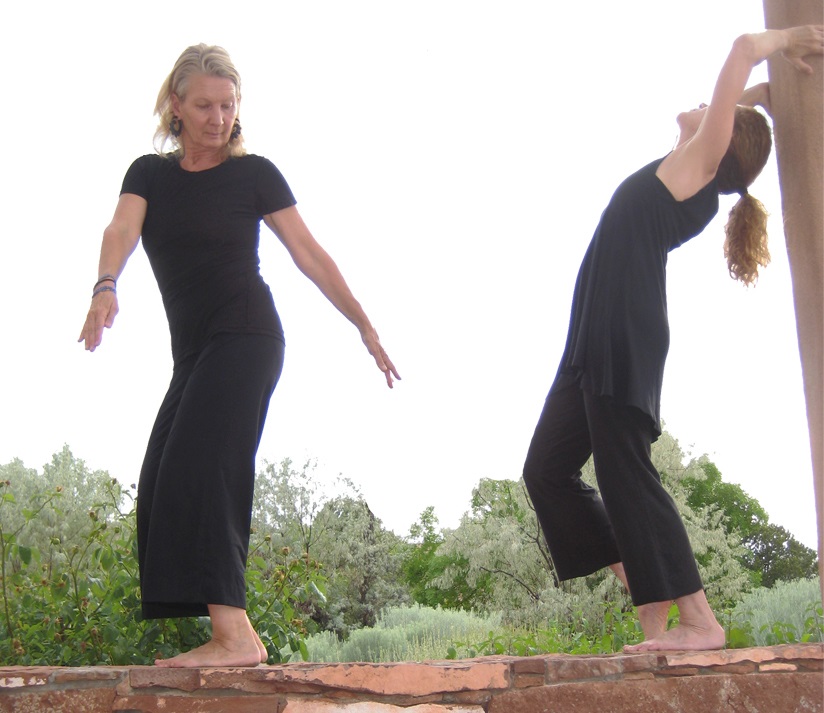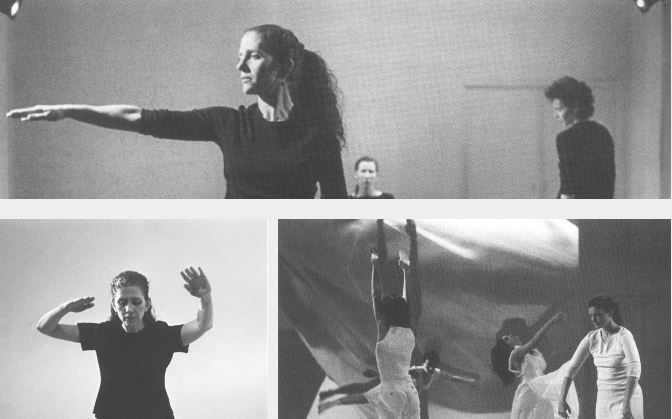Musings on Place and Space
BY EMMALY WIEDERHOLT
Leslie Satin is a New York-based choreographer and teacher at New York University who hails from the post-modern and downtown dance scene. She’s also a former Santa Fean who has returned to Santa Fe every summer for over 15 years. This summer, she created a piece, “Things Hanging in the Air,” on herself and fellow dancer Elise Gent; the accompanying text, which she wrote, was read in performance by actor Robyn Rikoon. Leslie describes her process, as well as her experience presenting work unfamiliar to Santa Fe audiences.
~~
How did you approach the creation of “Things Hanging in the Air”?
This piece came out of a trip I made to Israel with my husband earlier this year. I’ve been interested in Israel for a long time. I’m Jewish, secular, and drawn to the land. I had resisted going for years because of the political situation, the Occupation. I came to realize I didn’t want to go only as a political gesture; I really wanted to know what it felt like to be there, including the sense of conflict.
I’ve always been struck by what seems to be the disproportionate number of artists in this small country, especially experimental artists.
Right before my husband and I left for Israel, there was a shooting in Tel Aviv. Four people were killed in a café. As a result of this and so many other incidents, and because of the complex politics of the area, we expected to be in a state of high anxiety the whole time, but we weren’t. This unanticipated calm was one of the elements I would later explore in the dance.
I came back wanting to make a piece that had do to with my experience of the place. Earlier, I made dances about travel called Foreign Currencies, which I explained as dances imagining travel. Some had to do with places I’d actually been to, and others with places I’d never visited—the collective as well as the individual idea of a place. These, like the new piece, explored place through language, movement and image.
But when I started working on this piece, it moved away from Israel, the same way thoughts move. For example, if you are in New York, your thoughts might be in Paris or on something that happened 20 years ago. I may have a particular experience in and of a specific place, but it is colored by seemingly unrelated thoughts and feelings, and later, working on the piece, other material enters the “landscape.” For example, there’s a long spoken section in this piece that has to do with a very dear friend of mine who died a year ago. I was hiking near Santa Fe on the anniversary of her death, and was flooded with feelings about her. So I followed that. There’s the associative material that happens in a place, and then there’s the associative material that happens when you’re writing and remembering. For me, that associative quality becomes another subject to dig into.
I called the piece “Things Hanging in the Air” after a line in an essay by the anthropologist Kathleen Stewart. She uses those words to describe the sense of a place.
I’m interested in the interplay of words and actions. But, in my work, they never duplicate each other. They might be connected, but they won’t be literally connected. It’s the layering and juxtaposing of seemingly unrelated material that interests me. Both the spoken components and movement components of the piece are episodic, but the episodes never match.
Photo by Eric Gent
How do you attempt to describe what people should expect, especially since the material isn’t literal?
I look at autobiography as a form of fiction. I’m interested in words, language and affect. I’m not telling the audience that every word in the text is what really happened, and I’m certainly not telling it in any sequence. I’m not looking at identity politics. I’m looking at the confluence and discord of pieces of story as they happen at every phase of making something, and then as they happen to a viewer or listener.
Since folks in Santa Fe may not be familiar with your genre of work, what do you hope audiences take away?
All I can ask is for someone to be engaged. Maybe with a question — “What’s going on here?” — or curiosity. I don’t worry about boredom. I know that if someone comes to watch who has only ever seen one particular kind of dance, whether it’s ballet or hip hop, it may take a moment for them to recognize it’s not something they know. That sometimes makes a person uncomfortable, and other times not.
In New York, the situation is different. There’s more dance; there are more viewers. Certain people go often to see postmodern or downtown dance, others go to see African dance or ballet. Generally, viewers aren’t surprised to go to a dance performance where nobody does anything typically conjured up by the word “dance.” The need for more “crossing over” of dance viewers would be a good topic for another conversation!
The past few times I’ve presented work in Santa Fe, I’ve begun by coming out and talking about the work. I don’t explain the piece, but I might give a little background on how it began. I’ve had quite a few people tell me they like having that connection.
I don’t try to direct people toward a particular experience, such as laughter or sadness. I’m simply trying to invite people into an experience. People will have different feelings no matter what.
After seeing the piece, I followed up with Leslie.
In the piece, you have a line that speaks to the experience of space and place. Does this extend to the experience of space and place created by choreography?
Always, and in ways that are direct, oblique, metaphorical and intuitive. That’s why I make these dances and these nonliteral texts that I hope resonate in some way in terms of the experience of a place.
For the most part, my writing is reflective, and happens after the experience. So it becomes about not just the experience of being in a place, but the experience of recalling a place and the associations that arise from that.
To me, the experience of being in a place is connected to my interest in being present. Dancing is a constant shift and doubling of knowing exactly where everything is in your body. You have to know where your hips are, where your pelvis is, where your head is, etc., but you also can’t be thinking about it, because then you can’t dance. It’s that merging that’s so fascinating to me.
In a dance I made two years ago, a speaker described everything she saw a dancer, who was improvising, doing. Of course, the speaker wasn’t able to see everything or speak as fast as her eyes could take it in. A person can never see—or remember—everything.
Does it matter to you what your audience looks at? Do you purposefully guide the viewer?
I don’t quite think about it in terms of directing people’s eyes. I don’t want to sound coy, but I think about choreography in terms of what the piece needs. And then I trust that an audience will do what it does. I’m interested in the making and unmaking of spaces, whether it happens in the most literal of ways or metaphorically.
Photos by Tom Brazil
Watching the piece, I felt an incredible sense of control. Do you welcome happenstance, especially in terms of accidents?
I do. In the opening and closing grid sections, there is plenty of room for “accident”—for unplanned incident. The order of the material is completely improvised and based on individual choice as well as what the other person is doing. So you could opt as a performer to take the most comfortable and safe choices, or you could go for growth within the structure, which is what we mostly did.
But some aspects are frankly a matter of rehearsal.
Any other thoughts?
I’m really interested in the crossover of formalism and non-formalism. You can’t separate them; they refer to each other. This idea is instrumental to how I think about making work. I grew up in the Merce Cunningham studio; I was really schooled in what I consider a formalist approach to choreography. But then my eyes were opened to so much more in terms of how dance and movement make meaning. And I’ve since realized that even Cunningham’s work had many ways of making meaning.
~~
Leslie Satin is a choreographer, dancer, writer and teacher based in New York City. Her dances, interdisciplinary collaborations and workshops have been presented at many venues in NYC, as well as elsewhere in the U.S., and in England, Scotland, Brazil and Israel. Her performances, workshops and writing have been supported by residencies, arts organizations and university grants. Leslie holds a Ph.D. and M.A. in Performance Studies from NYU. She is a longtime faculty member at the Gallatin School of NYU. For more information, visit lesliesatin.com.


